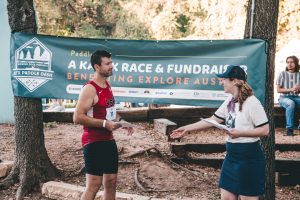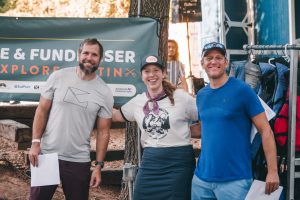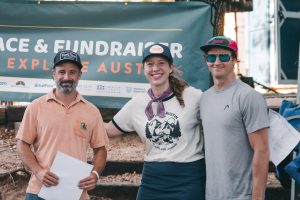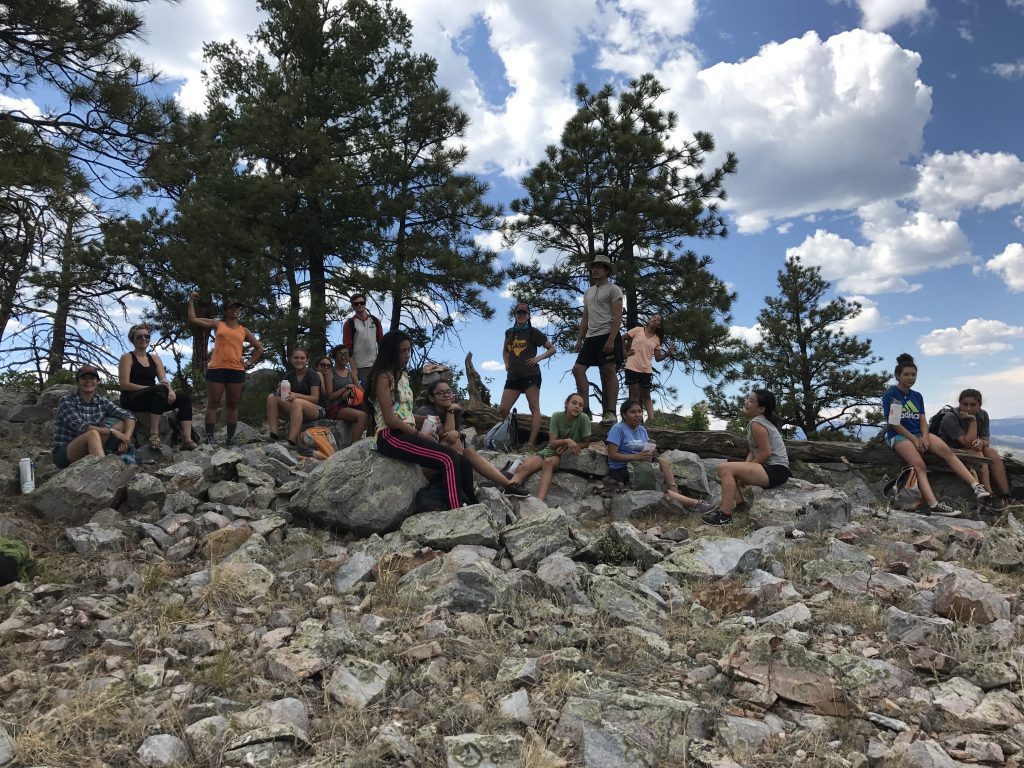2023 Girls “Turtle Squad” Mentor, Rocío Villalobos recently completed an incredible trek to Everest Base Camp alongside a powerful group of women from Native Women’s Wilderness.
We were fortunate to connect with Rocío and dive into her experience in the Himalayas.
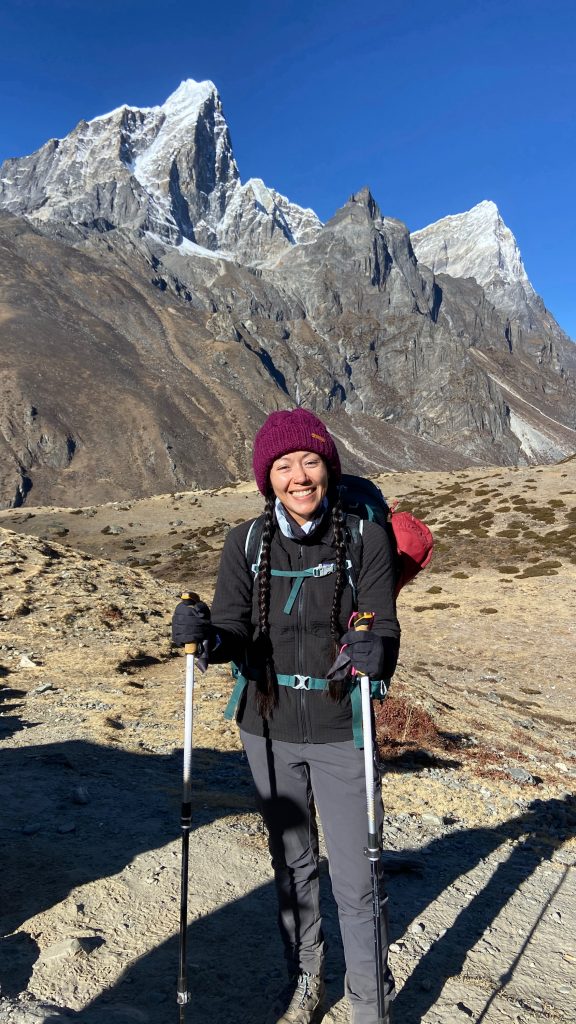
You recently got back from an expedition to Mt. Everest. How did the trip come about?
I was approached by Jaylyn Gough, who is the founder of Native Women’s Wilderness. She contacted me back in April of 2022 and said, “You know, I’m working on this project, I have this lifelong dream to go to Everest Base Camp and have that experience of trekking in Nepal. Are you interested?”. I had never imagined or dreamed about doing that trek or even getting to see Mt. Everest in person. I immediately knew that I had to say yes. It’s not an opportunity that I wanted to pass up.
She pitched the idea back in April and had been working on getting a small group of women together that included some of the current ambassadors for Native Women’s Wilderness. I’m also one of the ambassadors for the organization. We didn’t hear a whole lot of updates, and I wasn’t sure if the trip will still happening as of August. So, I sent her a follow up message and at that point, and she said, “Yes, we’re going to go” and took it from there.
Confirming in August for a trip in November?
November. Yes.
That’s incredible. What did the prep for the trip look like?
The work that Jaylyn did and the relationships she’s built through Native Women’s Wilderness were meaningful. We were privileged that there were a lot of gear sponsorships that came in for the women participating in the trip. There were certainly some things that we had to purchase out of pocket, but a lot of the bigger gear to make the trip safe and more comfortable was donated by different companies.
Physically, I was at a good starting point in that I run regularly, I do strength training regularly, and I do hike regularly. In terms of the physical aspect, I had a good foundation. The challenge of doing a trip like the Everest Base Camp trek, being from a place that is relatively flat or at a lower elevation, is that I didn’t really have the ability to train my lungs in the way that some of the other participants did. A few of the women who live in Colorado and New Mexico were able to get some of that higher altitude training. I think for me that was really the biggest challenge, it’s where I struggled the most, but physically the hiking of it, the day-to-day trekking was manageable. It was the altitude that really made me suffer in the end.
Was arriving in Nepal the first time that you all met each other?
In person? Yes. I have been on a few Zoom calls with some of the other women before I connected with Jaylyn through Instagram a number of years ago. So we already had that online, social media relationship. The same was true with a couple of the other women. For me personally, it was the first time getting to meet everybody in person.
After looking at all of your content on Instagram about your trip, the spiritual aspect of the trek really came through. Can you talk about that?
Going into this trip, I had a specific purpose in mind that was multifold. I was there to build relationships with the other indigenous women that were a part of this trip and to learn more about the areas we were visiting including the country of Nepal.
I also used this as an opportunity to honor my father and his memory since he passed away almost a year ago at the end of February 2022. All of us were showing up with some shared purposes and this bigger recognition or goal of being grateful for all of the people in our lives who have played a role in shaping who we are, supporting us along our different journeys, and the importance of remembering our connectedness to the land as well as our connectedness to this broader vision and work that’s happening around representation and racial equity in these outdoor spaces.
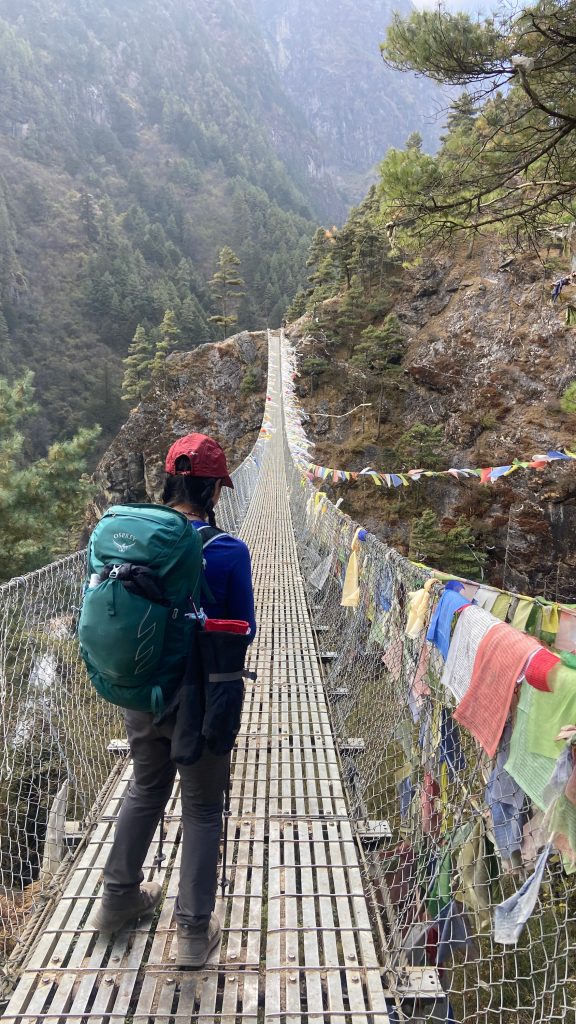
We each have different stories, but there is definitely a unifying thread for all of us. We all also really recognized the value of this trek and spending time in this space with each other as another vehicle for healing for our own mental health and wellness, but also the ways in which that ultimately also affects our ability to show up for our communities and the relationships that we have with the folks in our communities. Even though we were there as individuals, our collective impact and our goals were really much more far-reaching than just our individual experience.
Can you take us through the trip from arriving to Kathmandu? Did you unexpectedly go whitewater rafting?
Yeah! Everybody arrived at different times. A small group of us arrived about a week before, and others stayed about a week after the trek finished to explore and see more of Nepal. I didn’t expect for my first whitewater rafting experience to happen in Nepal, but some of the other women who arrived early happened to be rafting guides, so I felt like if I’m going to go whitewater rafting, why not go with two experienced guides that do this for a living, are super knowledgeable, and can help reassure me about doing something that is pretty scary for me since I’m not a strong swimmer.
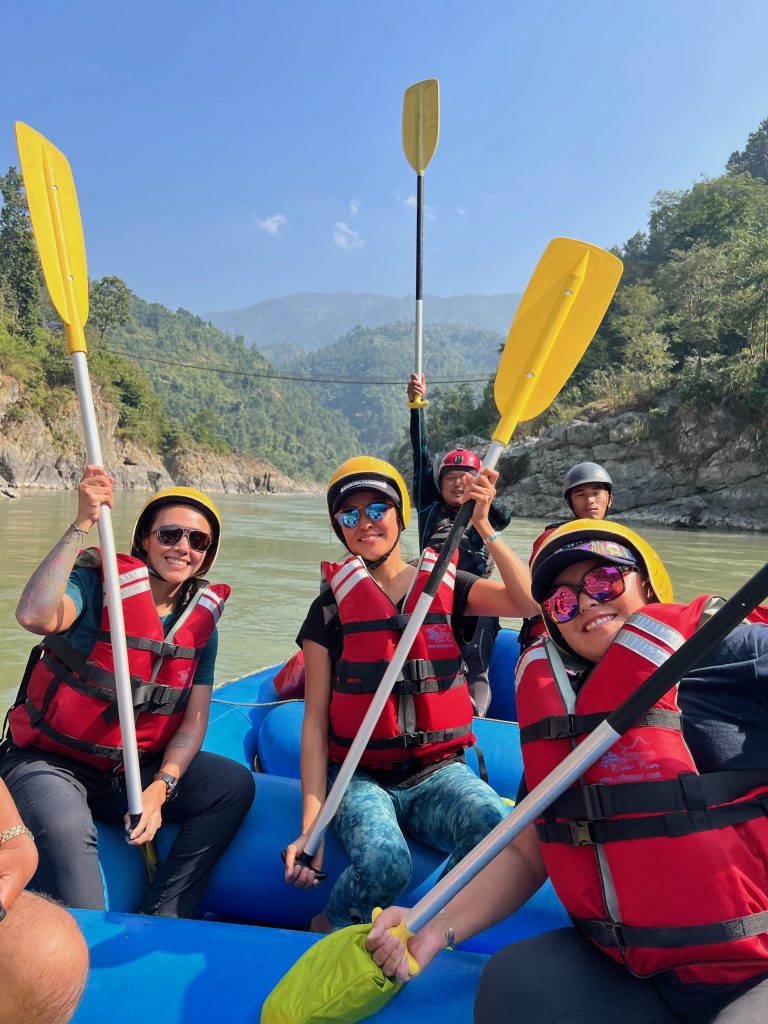
My first full day in Nepal was spent whitewater rafting, which was a beautiful experience. It ended up being a lot of fun and a little scary. The following day, we visited with some of the family members of the owners of the trekking company that we worked with, Trekking Planner Nepal and Adventure Tripper, and they showed us around Kathmandu. They welcomed us into their homes and showed us how they prepare a traditional Nepali meal, Dal Bhat. We were able to get this kind of very personal, intimate cooking lesson and just an opportunity to build relationships with some of the people of Nepal.
The day after that, everybody finally arrived from their different destinations, and we had our first dinner together and got an overview of what to expect for the next few days as we started the trek. The next day, we had to go through the process that those of us who are in Explore go through where you just have to try and weed out all of the unnecessary baggage. You know, the little extra things that you brought just in case. You decide what you’re going to take and what you’re going to leave so that you’re not weighing yourself down.
We did have porters who helped us with carrying some of our equipment. We were able to separate some of our gear into items that we were personally carrying in our daypacks and then items that our porters would carry, so that was a tremendous help. I don’t think we would have been able to do the trek without the help of the porters. They were immensely valuable in our ability to do the trek and not have to worry about carrying some of the heavier items.
We took it day by day. The entire trek itself is a total of 11 days. The first eight are working toward Everest Base Camp. It’s eight days to get to Everest Base Camp with a few days that are included to help acclimatize if you’re going up higher in elevation. We had two of those days where we stayed in the same location overnight and just did day hikes to go a little bit further up in elevation but still have a little bit extra time to just rest after we did the day hike. This is a little bit easier on the body, and it gave our lungs the chance to adapt. But as I shared, I really struggled a lot with the altitude, so I made the decision the day after we arrived at the Everest Base Camp that I was going to be helicoptered back instead of completing the final three days of the trek.
It sounds really dramatic. I was definitely struggling, and I don’t think I could have made it back down safely because of how I was feeling and the symptoms I was experiencing. The helicopter sounds, again, really dramatic, but it’s really the only way to get people down the mountain and back to the city so that they can get access to medical care. So I ended up having to do that after reaching the base camp, and some of the other women ultimately had to do the same. We started with ten, and of the ten, six completed the entire trek, including the return. All of us made it to base camp, but after base camp a lot of us were struggling and had to make the call to get medical attention.
What was it like coming off the mountain?
It definitely felt like an adjustment being back in the city of Kathmandu. After we were helicoptered out, we arrived to Kathmandu to get checked into the hospital for an initial observation. That first evening and then the following day, our group missed each other because even though it had been a relatively short amount of time, just those eight days, in some ways it felt like a lot longer than that.
When you’re going through a really difficult time together, again, not uncommon to what some of our Explore Austin teams experience with their Summer Wilderness Trips, you develop a closer bond. You connect with each other in a different way because you get to see each other at your highest highs and your lowest lows. When many of us were struggling at different points along the trek, we showed up for each other in different ways. Because of that, all of us were able to reach the base camp. That’s not the case for many groups that start on this trek in particular.
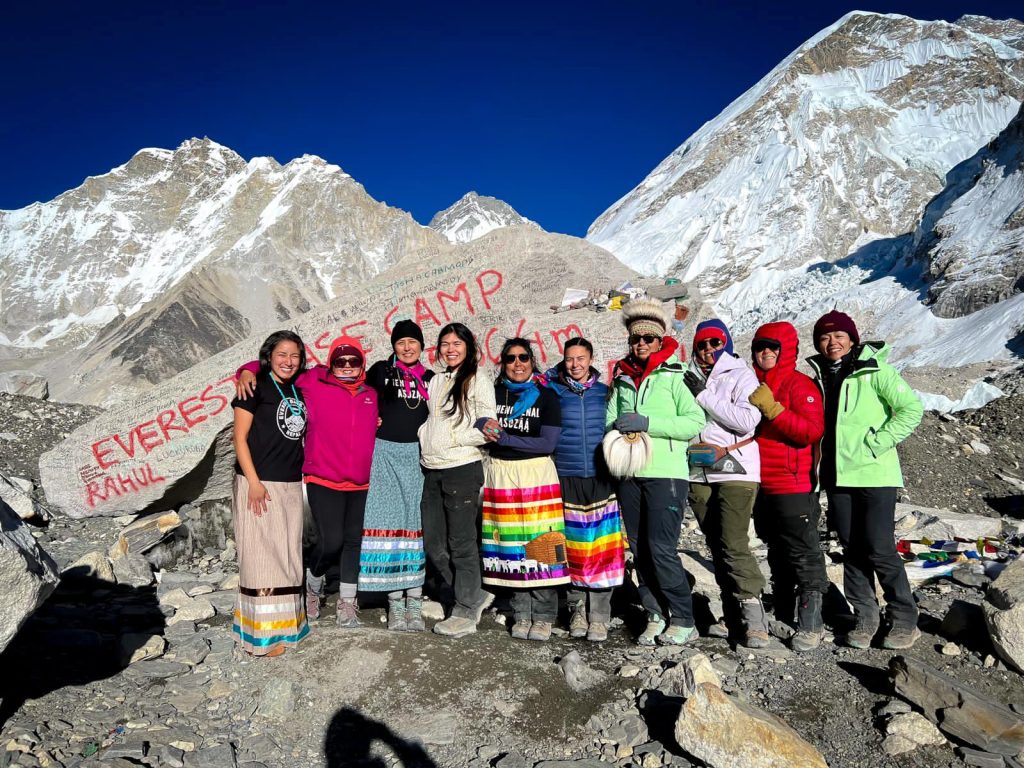
There are a lot of people who have to turn back because of the altitude or because they’ve developed some other kind of ailment that prevents them from being able to get to the base camp itself, let alone complete the entirety of the trek. We were invested in supporting each other so that we were all able to reach the base camp together. That played a huge role in all of us being able to reach it.
The other women who were helicoptered and I all shared the same thing: we felt alone. We knew that we weren’t of course, the folks from the trekking company and medics were there when we got to the hospital, so we knew that we had others who were checking on us there in Kathmandu, but we were also missing being on the mountain with the other women.
What were some of the biggest takeaways from the trip?
There were a lot of things that stood out to us from our experiences. One was just commonalities, even in terms of customs and traditions that women in our group carry compared with those we witnessed with the local Nepali people. These were simple things like dress and types of ceremonies. Every morning before setting out, local people would light juniper as a way to offer a blessing to the gods. That was similar to how we would start our treks with sage as a way to ground us and get us to a good mental space to begin the trek. It was a beautiful reminder of the similarities that exist across people. Connections exist between communities that are in very different parts of the country, or of the world, but have many things in common.
Another big piece for me had to do with nourishment. It’s easy to take for granted being able to get drinking water and not having to worry about possible consequences related to water. That’s not to say that it’s not a problem in the US, because we know what happens in the colonias and the US-Mexico border. We know what happened in Flint, Michigan. It was another reminder that we have a lot of privileges living in the US when we were going up the mountain and would see porters that had baskets strapped around their heads and were carrying food to communities that are at a higher altitude who needed food brought in from other parts of the mountain.
Food is something that is labor intensive, and it’s very easy for people to forget that it takes a lot to consume you know, an apple, let alone enjoy meat for a meal. So those are some of the things that really stood out to all of us. We felt really grateful for what we do have and acknowledged that it’s not the same for communities in other parts of the world, let alone other parts of the US.
Any other lessons learned?
I’m constantly being reminded that nothing is impossible. It feels kind of trite or cheesy, but if you had asked me a year ago, before Jaylyn reached out, if I thought I would ever see Mt. Everest or reach Everest base camp, I would have laughed and told you “No,” because it’s not something that I had ever dreamed of for myself. The things I imagine have been shaped by my environment and the people around me. I don’t have other people in my family or close friends who are doing these types of trips.
I’m really grateful for being reminded of how important it is to be able to dream about things that can feel impossible. We need to share these experiences and create opportunities so that people are able to have what feel like impossible dreams come true for them. The more we can share with young people in particular (I’m thinking about the youth who Explore serves), the better because if you’re able to start having these dreams at an early age, who’s to say what else you’re going to be able to dream up for yourself.
What’s next on the horizon for you?
The next big challenge for me related to the outdoors is a lottery I’ve entered for my first 50-mile race. I’m hoping to be able to compete this year. It’s been on my bucket list for a couple of years, but I’ve been struggling on and off with some running related injuries.
I’m starting the year feeling really committed to staying injury free. I think being in Nepal actually helped me to remind myself to go slow and to listen to what my body is telling me so that I am as healthy as I can be and well mentally and emotionally. So that’s really my big goal for this year and hopefully a trip to Mexico with my mom to visit family because it’s been about 15 years since we went.
That’s another piece for me on a more personal level to which I’m really trying to commit. Strengthening and reconnecting with some of our family in Mexico is important because those relationships are really important. I feel myself turning toward this a lot more. I don’t want to lose sight of how important and how crucial it is to hold on to some of those familial and cultural connections. All of that really shapes who we are and the way that we move through the world. So those are the big things for 2023 for me.
Amazing. Thank you for taking the time to visit with us, Rocío!
Keep up with Explore Austin by following us on Instagram, Facebook, LinkedIn and Twitter.
